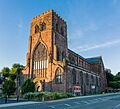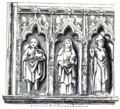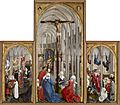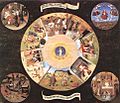John Mirk facts for kids
Quick facts for kids John Mirk |
|
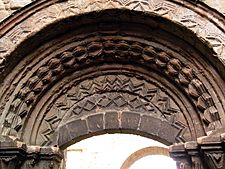 Arch and tympanum over the processional entrance on south side of the church, Lilleshall Abbey |
|
| Born | 14th century in |
|---|---|
| Died | 15th century in Lilleshall Abbey |
| Nationality | English |
| Church | Catholic Church |
| Other names | Johannus Myrcus, John Myrc, John of Lilleshall |
| Ordained | Priest |
| Writings | Festial, Instructions to Parish Priests, Manuale Sacerdotis |
| Title | Prior of Lilleshall Abbey |
John Mirk was a religious leader called an Augustinian Canon. He lived in Shropshire, England, in the late 1300s and early 1400s. He wrote popular books to help parish priests and other church leaders do their jobs better. His most famous book, called Festial (or Book of Festivals), was probably the most printed English book before the Reformation.
The Life of John Mirk
Who Was John Mirk?
John Mirk was a canon at Lilleshall Abbey, a type of religious community. Later, he became the prior, which means he was the leader of the abbey. We don't know much about his personal life.
Most people thought he wrote his books around the year 1400. But now, experts believe he started writing earlier, probably in the 1380s. His name and the way he used language suggest he might have come from northern England. He cared a lot about helping people with their spiritual lives. His work was very important for the people of Shrewsbury and the areas around it during his time.
England in Mirk's Time: Challenges and Changes
John Mirk lived during a time of big changes in England. A terrible disease called the Black Death had killed about half the population. This had huge effects on society, the economy, and people's spiritual lives.
Before the Black Death, Shropshire faced problems like cattle diseases and bad harvests. Later, during the early years of King Henry IV's rule, there was more trouble. A rebellion led by Owain Glyndŵr and other unhappy English nobles caused a lot of damage in many areas.
Lilleshall Abbey, where Mirk lived, was founded in the 1100s. It was connected to the town of Shrewsbury because it owned land nearby. The abbey had some tough times in the early 1300s due to farming problems and bad leaders. But it managed to recover well and became stable again by Mirk's time.
Another important monastery nearby was Shrewsbury Abbey. This abbey was famous for its relics of Saint Winifred. Relics were thought to have special powers. Monks from Shrewsbury Abbey even stole relics of another saint, St Beuno, to add to their collection.
Religious Ideas and Challenges
During Mirk's time, there were new religious ideas spreading. One group was called the Lollards, led by John Wycliffe. They believed that the Bible should be in English so everyone could read it. They also questioned some church practices, like worshipping images or relics. They thought pilgrimages (religious journeys) were not useful.
In 1407, a Lollard preacher named William Thorpe gave a sermon in Shrewsbury. He said that God's Word in the Bible was most important, not sacraments or images. This was very different from what people usually believed in the area. Local people had strong traditions like the cult of St Winifred and big celebrations for Corpus Christi.
Thorpe was arrested and questioned. The church leaders saw Lollardy as a threat. John Mirk's writings were definitely against Lollard ideas. His Festial book even directly disagreed with them. It's possible his books were shared to help fight against Lollard teachings in the middle of England.
John Mirk's Important Books
The Festial: Sermons for Special Days
Mirk's Liber Festivalis, or Festial, is a collection of sermons for important church holidays throughout the year. He started with Advent Sunday and went all the way to All Saints' Day. Each sermon included stories to help explain the main idea.
Mirk got many of his stories from the Golden Legend. This was a very popular collection of stories about saints from the 1200s. Mirk chose to write his book in Middle English, the common language of the time, instead of Latin. This was a big decision because the Lollards also wanted religious texts in English.
Mirk's stories sometimes seem simple to us today. For example, in his sermon for Corpus Christi, he defended the idea of Transubstantiation (the belief that bread and wine become Christ's body and blood) with a story. The Lollards did not believe in Transubstantiation.
Here's a part of that story, simplified:
| Original | Modern |
|---|---|
| This byschop had wyth hym of his clerkys þat beleuet not perfitly in þe sacrament of þe auter, and sayde þat þai myȝt not beleue þat Crist schedd his blod in þe masse. Then was þis bischop sory for her mysbeleue and prayed to God ȝorne for her amendement. And so, on a day, as he was at his masse, when he had made þe fraction as þe maner is, he saȝe þe blod drop doun from þe ost fast into þe chalice. Þen he made syne to hem þat mysbeleuet, to come and se. And whew þei saue his fyngurys blody and blod rane of Cristis body into þe chalis, þai weron agryset þat for veray fer þai cryet and sayd : Be þow blesset, man, þat has þis grace þus to handul Cristis body! We beleue now fully þat þis is verray Godis body, and his blod þat dropet þer into þe chalis. But now pray to hym þat þou hast þer in þi hondys, þat he sende no vengauwce vpon vs for oure mysbeleue! and so þe sacrament turnet into his forme of bred as hit was beforn; and þai weren good men and perfyte alway aftyr in þe beleue. | A bishop had some church helpers who didn't fully believe that Christ's blood was shed in the Mass. The bishop was sad about their doubt and prayed for them. One day, during Mass, after he broke the Host, he saw blood dripping from it into the chalice. He called his helpers to see. When they saw his bloody fingers and the blood, they were terrified. They cried out, "Blessed are you, who can touch Christ's body like this! We now fully believe this is truly God's body and blood!" They asked him to pray that God wouldn't punish them for their doubt. Then the bread returned to its usual form. After that, they were good and faithful believers. |
Mirk also directly disagreed with Lollard ideas about images in churches. He argued that images like crosses helped people remember Christ's suffering.
| Original | Modern |
|---|---|
| For as Saynt Austyn sayde : Þe mynde of Cristis passion is þe best defence aȝens temptacions of þe fende. Herefor ben roodes sett on hey in holy chirch, and so by syȝt þerof haue mynd of Cristis passion. And þerfor roodes and oþyr ymages ben necessary in holy chirch, whateuer, þes Lollardes sayn. | As St Augustine said: remembering Christ's suffering helps protect against the Devil's temptations. That's why crosses are placed high in churches. Seeing them helps you remember Christ's suffering. So, crosses and other images are needed in the church, no matter what these Lollards say. |
Mirk's Festial also showed his interest in local concerns. For example, he wrote a sermon for the feast of Saint Winifred, a Welsh saint whose relics were brought to Shrewsbury. He also wrote about St Alkmund, a saint important to Lilleshall Abbey. Mirk's sermons tried to explain traditional beliefs in a way that answered the Lollards' questions.
Over 40 copies of the Festial still exist. It was very popular and was printed many times, even by famous printers like William Caxton and Wynkyn de Worde. It was widely read until the 1500s.
Instructions for Parish Priests: A Guide for Clergy
Mirk's Instructions for Parish Priests is a long poem written in lively English. It has 1934 lines and uses rhyming pairs of lines. Mirk said he translated it from a Latin book, but it seems he actually used ideas from older church manuals. This book was likely written before he became prior of Lilleshall Abbey.
The book was meant to help priests teach their church members the basics of the Christian faith. The church had a clear list of things everyone needed to know. These included:
- The Creed (a summary of beliefs)
- The Ten Commandments
- The Seven Sacraments (like baptism and communion)
- The Seven Deeds of Mercy (like feeding the hungry)
- The Seven Virtues (like faith and hope)
- The Seven Deadly Sins (like pride and greed)
Mirk knew that many priests didn't have much education. He wanted to make sure they could guide their communities properly. He wrote:
| Original | Modern |
|---|---|
|
God seyth hym self, as wryten we fynde, |
God says, as we find written, |
The Instructions covers many topics. It tells priests to live a good life. It gives advice on baptism, childbirth, and the role of midwives. It also talks about the Eucharist (communion). Mirk also warned against playing games in churchyards, not paying tithes (church taxes), witchcraft, and usury (charging too much interest). He said that selling things at too high a price was like usury.
| Original | Modern |
|---|---|
|
Vsure and okere þat beth al on, |
Teach them not to practice usury or "okering," which are the same; |
The book then follows the six main points of the church's teaching. It includes the Lord's Prayer and a short version of the Hail Mary in English. It explains the Apostles' Creed, the seven sacraments, and how to hear confession. It uses the Ten Commandments, Seven Deadly Sins, Seven Deeds of Mercy, and Seven Virtues to guide the questions a priest should ask. Finally, it explains penance and the Last rites.
Only seven copies of the Instructions still exist. This might be because it was used so often that copies wore out.
The Manuale Sacerdotis: A Priest's Deeper Guide
The Manuale Sacerdotis, or Priest's Handbook, was probably written around 1400, when Mirk was prior of Lilleshall. Unlike his other books, this one was written in Latin. This means it was meant for priests who had more education.
This book aimed to help priests understand the deeper meaning of their role. Mirk compared good priests to modern ones who were distracted by worldly things. He explained the priest's daily activities, including canonical hours (daily prayers) and celebrating the Eucharist. He again explained the idea of Transubstantiation, using the same story of St Oda from his Festial.
Mirk wanted to show how a priest's outward actions were connected to their inner spiritual life. He believed that living by a rule was very important, saying, "life without a rule is nothing less than dying." He encouraged priests to follow the principles of Christ's own life.
The Manuale is less known than Mirk's other works because it was in Latin and probably not read by as many people. Thirteen copies of this book are known today.
Images for kids
-
Pews at St Peter's Collegiate Church in Wolverhampton. These were originally Lilleshall Abbey choir stalls, where the canons sat during worship, and were donated to the church after the Dissolution of the monasteries.
-
The church of Shrewsbury Abbey, although now a much truncated parish church, remains a dominant feature of the western approach to the town.
-
A Victorian picture showing Arundel and other Lords Appellant confronting King Richard II.
-
The start of the Gospel of John from a copy of John Wycliffe's translation. Having the Bible in English was a key idea of the Lollards.
-
A carved stone, thought to be from Shrewsbury Abbey, showing St Winifred with John the Baptist and St Beuno.
-
A mid-1400s painting of the Seven Sacraments by Rogier van der Weyden.
-
The Seven Deadly Sins and Four Last Things (1485) by Hieronymus Bosch.
-
A manuscript of The Imitation of Christ by Thomas à Kempis, an Augustinian writer, from about 1418.



